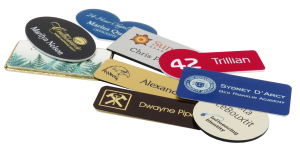…And Other Wisdom from Your Name Tag Experts
People wear a name tag at social events to help remember each others’ names. In the business world, these tags serve a bigger purpose. They have a subconscious effect on the viewer that enhances a company’s networking, branding and promotional efforts. At trade shows and conventions, people wear name tags to promote their brand and establish professional relationships. In retail, they improve customer and employee relations. People respond to them wherever they show up.

Retail employees and convention attendees frequently wear name tags. Some people wear them at conferences, trade shows, business luncheons or sporting events. Politicians sometimes wear them, usually with a support message along with their name and title so that viewers will remember their cause as well as their name. In short, many people wear name tags for different reasons.
A name tag is a personal identification tool that helps you become more relatable and approachable. Many people use them, including politicians, business managers and conference attendees. The effectiveness of wearing one depends on following guidelines such as keeping your name tag simple and using the right fastener. It is also important for them to have a large font so that people can read them easily. Not only are they used for identification, but they are also used as corporate gifts to strengthen your work relationships.
Be Approachable by Using a Name Tag
Scott Ginsberg, the Name Tag Guy, said, “The first idea to remember is that approachability is a two-way street. It’s both you stepping onto someone’s front porch, and you inviting someone to step onto your front porch. It connects people to you. It allows them to feel more comfortable talking to you.”
When someone is relatable, it means people can draw similarities between that person and themselves. Customers want to feel they have a connection with a company and its employees. It makes them think they can trust the company to do what is in a customer’s best interest. Therefore, when a company and its employees are relatable, people feel comfortable doing business with them. Relatability is, therefore, a valuable asset that helps a company become successful.
Name tags play a significant role in increasing relatability. When a person wears a name tag, it humanizes them. It makes them relatable and more approachable. People are more willing to interact with a stranger in a retail store, conference room or trade show if that stranger is wearing a name tag.
The Seven Deadly Sins of Ineffective Name Tags
Scott Ginsberg, an international expert on name tags and approachability, wrote a list of “Seven Deadly Sins” to avoid when ordering them. The purpose of this list of “sins” is to educate people on what makes them ineffective and how to avoid them. Ginsberg stresses the link between name tags and approachability.
“Your name tag is your best friend. It is a lifesaver in meetings, trade shows and events to start conversations when you meet groups of new people. It also identifies you as well as your company in the minds of others.”
SIZE
Nobody wants others staring awkwardly at their chest, trying to read their name tag. “This is self-defeating, embarrassing and works to decrease your approachability.” It should be readable from at least 10 feet away, thus making the recommended font size a minimum of 24 point. Avoid cursive, script or other fancy writing styles.
COLOR
For name tags, complementary colors create maximum visibility. Whether it is dark writing on a light background or vice versa, what matters is that the name, title and business logo are easy to see. “Fashion must be outweighed by your name tag’s approachability and visibility.” Many color combinations allow viewers to read tags without any awkward squinting or leaning. Find the best match for your brand that gives you both readability and recognition.
TURNAROUND
Another problem to avoid is what Ginsberg calls “the name tag turnaround.” It refers to when a name badge turns so that the information on the front is hidden, and there is no information on the back. Typically, this happens when the tag is worn around the neck on a lanyard or worn with a clip. To avoid having “name tag turnaround,” write the same information on both sides.
CLUTTER
“Avoid name tags with overly thick borders, unnecessary clutter or too much text. All of the information contained must be readable and memorable in less than five seconds. Remember, they call them name tags because the name is the focal point. Whether it’s the name of the person or the name of the company, those are the two most important pieces of information.”
PLACEMENT
Placement refers to where someone wears their name tag, such as on the right or left side of their shirt. Which side the tag should be on depends on where the person is or what type of function they are attending. For example, when at a conference or convention, the name tag should be worn on the left side because that way it is more visible to people walking from the opposite direction. At corporate meetings or other office events, they should be on the right side because when the wearer greets people by shaking their right hand, the tag is parallel with the viewer’s line of sight. Do not decrease a name tag’s effectiveness by wearing it on the wrong side.
PRESENCE
Similar to placement, presence has to do with putting the name badge in a place where it is the most visible to any viewer, regardless of wearing it on the right or left side. The name tag should be where people can see it but also be able to see the person’s face. According to Ginsberg, “the most effective location is two to three inches below your collarbone on whichever side most appropriate for your function.”
MAXIMIZATION
To make the most of wearing a name tag, utilize all the space it provides. Have your name in a larger font so that a lot of white space does not surround the text. If the tag includes a logo, the logo and text should fill up as much of it as possible. Like the front porch of a house, a name tag is meant to be inviting and make others feel comfortable. When used to the fullest capacity, they become more visible and welcoming. It initiates conversations that can turn into valuable business connections.
By avoiding these seven “deadly sins,” name tags become more efficient and improve a person’s approachability.
How to Make Your Name Tag Effective
A name tag helps to make you look professional. When someone wears one appropriately, it indicates that they take their job seriously. In turn, this helps create an excellent first impression when meeting with potential clients and investors.
In addition to looking professional, people tend to act more qualified when they wear a name tag. And, they are more aware of how much they are accountable for their actions. For example, if a customer needs help, employees are quickly identified if they are wearing their name tag.
Include Relevant Text
Add titles on your name tags in office settings or retail environments. Titles help make managers and head staff stand out a bit more from other employees. Titles are also helpful during a conference or convention to separate attendees from venue staff and event volunteers. While typically titles are kept brief, it is important not to sell anyone short when using their title. So, make sure to order your tags in an appropriate size to adequately accommodate all of the text.
Don’t forget about visibility. All text should be readable from a distance, typically about 10 feet. Don’t add too much text to one line as it could become too small to read even from close up. And, make sure that all included text is relevant to your event or business.
For a name tag to be the most effective, there are guidelines to consider. The first rule is to keep yours simple. Some people treat them like business cards or resumes, but personal identification should be straightforward and concise. Name tags should only include the bare minimum information necessary to identify the person wearing it. In commercial and retail settings, that means the person’s first name, unless there is more than one employee with the same first name. With such cases, adding a last name helps with identification.
Brand with a Logo
Another recommendation to consider is where and how to include a company logo. The logo should be an appropriate size so that it doesn’t crowd the name or title. And, the layout needs to be tidy. If the text is laser engraved, the logo will have limitations to a specific color or printing format. Full-color tags provide the user with brighter colors and the option of bleeds. These are useful for logos that are large or require particular colors.
Use of a logo depends on the style of the name tag. Metals will show logos far differently than plastic will. It is important to choose whichever type of name tag works best for the person wearing it. Plastic name tags tend to be less expensive than metal ones, are heat resistant and come in many different shapes. Metal name tags are more durable than plastic ones but also heavier. Some people prefer a lighter name tag, especially if they wear loose clothing. Make sure to choose the right material before ordering the name tags.
You can increase your brand recognition by including logos. People associate the company logo and employees with the organization when employees wear logo name tags at conventions and trade shows. Another benefit to having a logo is that employees tend to keep their name tags on when they go on their lunch break or commute to and from work. By doing so, they advertise the company to the public and make the brand more memorable.


